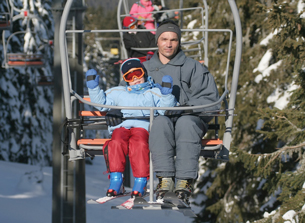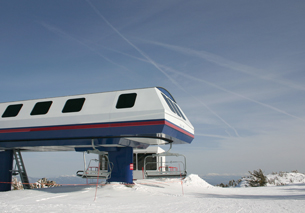Module 6—Work and Energy
 Reflect and Connect
Reflect and Connect

© kristian sekulic/shutterstock
If a new high-speed, quad chairlift replaces a slower, double chairlift, will it cost more to operate? Assuming that the energy lost due to non-conservative forces, such as friction, is identical for both lifts, the high-speed lift is still more costly to operate at the same capacity. The high-speed lift requires more power to run at higher speeds. However, it will transport more riders per day while exposing skiers to less severe winter weather since they spend less time on the chair and more time skiing. The following table compares the two types of lifts.
| Low-Speed Double Chair | High-Speed Quad Chair |
|
|
Now, consider the fact that most lifts do not operate at full capacity. If fewer riders are on the lift, and the power supply is not adjusted, the lift would increase in speed. With more riders and a constant power supply, the lift would slow down. In order to prevent this, the power supplied to the lift cable is adjusted to maintain the speed of the lift as the mass of riders getting on and off changes. This is done to increase efficiency and ensure most of the work done by the motors is converted to the gravitational potential energy of the riders. If the power is not adjusted according to the number of riders on the lift, the kinetic energy of the system would increase and more energy would be lost due to friction. This, in turn, leads to higher operating costs.
 Module 6: Lesson 4 Assignment
Module 6: Lesson 4 Assignment
Remember to submit the answers to D 1 and D 2 to your teacher as part of your Module 6: Lesson 4 Assignment.
 Discuss
Discuss

© Douglas Litchfield/shutterstock
In the discussion forum, answer the following two questions.
D 1. Assumptions have been made in this lesson that the energy lost operating a low-speed chairlift is the same as the energy lost operating a high-speed lift of equal path length. Why is this assumption false? What impact does this have on the efficiency of the lift?
D 2. How could efficiency be maximized on a chairlift that can have anywhere from 0 to 2400 riders per hour?
 Reflect on the Big Picture
Reflect on the Big Picture
Each of the Reflect on the Big Picture sections in this module will ask you to consider gravitational, frictional, or elastic forces. Complete at least one of these reflection activities:
- Imagine that you are the owner of a new ski resort. Search the Internet for at least two manufacturers of ski lifts. From the information you find and what you have learned in this unit, decide which ski lift you will buy. To support your choice, build a chart or other graphical presentation of the ski lifts and write a short summary explaining the choice you have made. Be sure to consider energy efficiencies in your summary.
- Imagine that you are the owner of a new ski resort. In a world with increasing energy costs, using efficient equipment might be the difference between business success and business failure. Prepare a list of decisions that you will have to make over the next few years that relate to energy efficiency.
Store your completed reflection in your Physics 20 course folder.
Add to the KWL chart you worked on in Module 5 and in Module 6. Continue to store your chart in your Physics 20 course folder. You will submit this KWL chart to your teacher as your Unit C Assignment.
 Module 6: Lesson 4 Assignment
Module 6: Lesson 4 Assignment
Remember to submit the Module 6: Lesson 4 Assignment to your teacher.